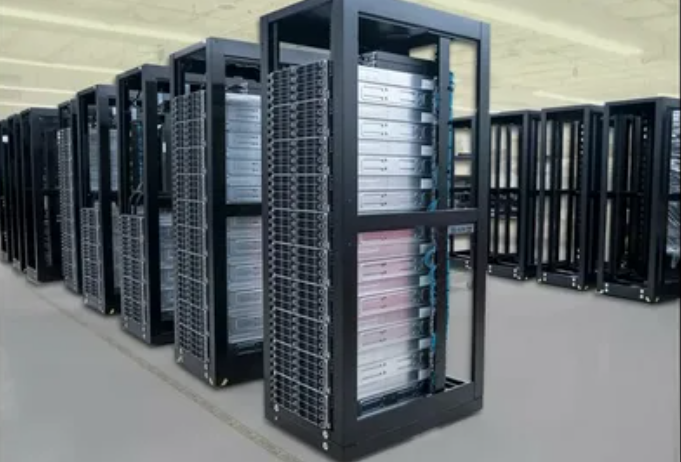Blade servers present several advantages, encompassing optimum server density, scalability, energy efficiency, and streamlined resource allocation. Their endorsement of virtualization technologies further elevates their attractiveness by allowing organisations to optimise the use of resources and promptly adapt to changing business demands.
Today we will take a look at why blade servers are the future of data centre business.
Significantly Smaller Footprint
Blade servers embody a design philosophy prioritising compactness and modularity, thereby facilitating the integration of numerous server blades within a singular chassis. Traditional rack-mounted servers tend to require a larger physical footprint due to their self-contained nature. These servers, conversely, diminish the physical dimensions of individual servers. Blade based servers frequently incorporate enhanced cooling designs, thereby optimising the efficacious elimination of hot air from the chassis. The aforementioned phenomenon enhances temperature control within the data centre, mitigating the potential hazards associated with overheating and obviating the requirement for excessive cooling infrastructure.
Reducing Overall Energy Consumption
The practice of power supply sharing among various server blades is commonly observed within blade server chassis. This phenomenon leads to a reduction in the required quantity of power supplies and a decrease in energy loss during the process of conversion and distribution. As a consequence, power usage becomes more efficient. Blade systems are equipped with dynamic power management functionalities. These characteristics have the capability to adapt the power utilisation of individual server blades in accordance with workload demands, thus diminishing power consumption during periods characterised by reduced activity.
Simplified Management
Blade server systems are equipped with centralised management tools or management modules integrated within the chassis, enabling administrators to effectively control and monitor all server blades from a single location. This centralised mode facilitates server administration through the provision of a singular interface for the purposes of configuration, monitoring, and troubleshooting. These devices are specifically tailored for expeditious deployment. The inclusion of new server blades to the chassis can be executed in an expedited manner, while the initial configuration and provisioning processes frequently entail a comprehensible procedure. This attribute of agility mitigates the temporal and laborious demands associated with the deployment of server systems.
Flexibility and Scalability
Blade chassis facilitate the integration of disparate components through a versatile combination method. Administrators have the flexibility to select diverse server blade models incorporating differing CPU, memory, and storage specifications in order to establish a heterogeneous infrastructure tailored to their specific requirements. These systems possess high levels of scalability, exhibiting the ability to expand in both vertical and horizontal dimensions. Vertical scalability is the act of augmenting additional resources such as memory or CPUs to individual server blades, whereas horizontal scalability pertains to the addition of more server blades to the chassis. The aforementioned scalability feature facilitates the seamless incorporation of expanding workloads.
Optimising Resource Utilisation
Blade servers exhibit the characteristic of sharing fundamental infrastructure components, such as power supplies, cooling fans, and network switches, within the confines of the enclosure. This sharing approach mitigates the presence of superfluous components and minimises resource wastage, thereby facilitating improved efficiency in power and cooling resource utilisation. Blade systems have the capability to implement load balancing mechanisms in order to achieve equitable distribution of workloads among server blades. This mechanism effectively mitigates the occurrence of resource bottlenecks on individual blades, thereby guaranteeing optimal utilisation of the available resources.
High Server Density
These server enclosures are capable of accommodating numerous blades within a unified chassis, typically encompassing a range of 6 to 16 blades or beyond. The integration of numerous servers into a solitary enclosure results in the mitigation of spatial requirements for separate server units.
Well-Suited for Virtualization Technologies
Blade servers possess a multitude of desirable characteristics, such as a high server density, a modular design, a shared infrastructure, and centralised management. These advantageous attributes make blade systems an extremely advantageous option for organisations seeking to enhance the efficiency of their virtualization environments and effectively handle virtualized workloads.
| Aspect | Description |
Resource Allocation | Centralised management tools allow administrators to allocate CPU, memory, and storage resources to individual VMs. This dynamic resource allocation ensures that VMs receive the resources they need when they need them, improving overall performance. |
Optimised Networking | Blade based server enclosures often have integrated networking options, including Ethernet switches and Fibre Channel modules. This simplifies network connectivity for VMs and ensures that networking resources are efficiently utilised. |
Rapid Provisioning | Blade systems support rapid provisioning and deployment of VMs. Administrators can create, clone, or migrate VMs quickly, responding to changing business needs with agility. |
Redundancy and Failover | Blade systems can be configured with redundancy and failover features to enhance the availability of virtualized workloads. In the event of hardware failures, VMs can be automatically migrated to healthy blades, minimising downtime. |
Modular Design | They have a modular architecture, making it easy to add or remove server blades to meet changing virtualization demands. Organisations can scale their virtualized environments quickly and efficiently. |
Conclusion
Blade servers undeniably epitomise a supremely efficient and flexible solution for contemporary data centre environments. The compact nature, shared infrastructure, and centralised management of these devices render them highly suitable for organisations aiming to optimise their IT infrastructure. Blade servers have demonstrated their value as a valuable asset for companies of various sizes by facilitating reductions in physical footprint, streamlining server management, and enhancing energy efficiency.

